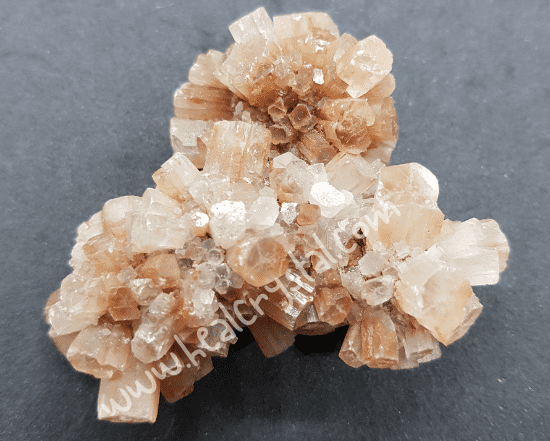Aragonite Crystal – Healing Properties, Zodiac Signs and Chakras
What is Aragonite?

Aragonite is one of the oldest crystals in terms of formation. The crystallization of Aragonite formations, the raw materials of pearl and mother-of-pearl, dated back two and a half billion years ago. Old crystals have an essential common feature. They usually contain organic material. For this reason, they form the crystal group that includes the most ecological and world information. Based on this, we can say that these crystals increase our environmental concerns and remind us that we must exist in harmony with nature. Ancient people used Aragonite crystals for grounding and patience.
Aragonite in our root chakra supports our self-satisfaction. This satisfaction involves accepting situations we cannot change after doing everything we can. Therefore, it can be useful in preventing anger, depression, and traumas. It helps us focus more on the place of restlessness.
Aragonite can support bone and tooth repair by increasing calcium absorption. It can have preventive and healing effects against muscle pain and joint problems. Due to its purifying properties, it can benefit pollen allergy or inflammation by stimulating our immune system. It can be very relieving in pain and injuries.

Aragonit in our knee chakra is very useful in disciplining and problem-solving. It increases our tolerance by bringing us both physical and mental flexibility. It helps us create the Yin / Yang balance that reflects our masculine and feminine energy.
Aragonite in our earth star chakra is very effective in relieving the geopathic stress in the ley lines. For this, putting aragonite crystals at intervals on our house or garden’s borders is sufficient. With this grid, we can both ground our house and be protected from all negative vibrations. We can also feel safe harmonizing with the world. We can show patience and perseverance in seeking solutions for all the problems we encounter.
For Aragonite Crystal’s detailed benefits, check out the charts where we combine the benefits and chakras most effectively.
| Base | -Acceptance- -Ache- -Anger- -Bone Repair- -Calcium Absorption- -Childhood Traumas- -Depression- -Digestive System- -Fear- -Fever Balance- -Focusing- -Hair Loss- -Hand/Foot Warms- -Immune system- -Inflammation- -Muscle Spasms- -Pain- -Pollen Allergy- -Reliability- -Restlessness- -Reynaud’s Disease- -Satisfaction with Yourself- -Sleep Problems- -Stress- -Stomach Problems- -Tooth- -Wounds- |
| Knee | -Disc Flexibility- -Discipline- -Flexibility- -Patience- -Solving Problems- -Tolerance- -Yin/Yang Balance- |
| Earth Star | -Frequency of the Earth- -Geopathic Stress- -Grounding- -Meditation- -Ley Lines- -Protection- -Reliability- -Root Cause of Problems- |

aragonite types
Aragonite is a calcium carbonate mineral that can occur in various forms and colours. Here are some notable types and varieties of aragonite:
- Sputnik Aragonite: This type of aragonite gets its name from its distinctive, spherical crystal clusters that resemble the shape of a Sputnik satellite. It often exhibits radiating needle-like crystals, forming spherical or globular aggregates.
- Flos Ferri Aragonite: Also known as “iron flower aragonite,” this variety is characterized by its delicate, flower-like crystal formations. It typically consists of thin, feathery or fern-like aragonite crystals that intertwine to create intricate and captivating structures.
- Pisolitic Aragonite: Pisolitic aragonite, also called “oolitic aragonite,” is composed of small, rounded spherical grains called “pisoliths.” These pisoliths are typically found in sedimentary environments and can form larger accumulations known as “oolitic limestone.”
- Fossil Aragonite: Aragonite can also be found in fossilized forms, where aragonite crystals have replaced the original organic material. Fossil aragonite can be found in various fossilized shells, corals, and other marine organisms.
- Cave Aragonite: Aragonite formations in caves are known for their stunning speleothems, including stalactites, stalagmites, and cave pearls. These aragonite formations occur due to the precipitation of calcium carbonate from water in cave environments over long periods.
- Blue Aragonite: While aragonite is typically white or colourless, blue aragonite is a rare and highly sought-after variety. It exhibits a beautiful blue colouration, often with hints of green or turquoise. Blue aragonite is prized for its aesthetic appeal and is popular among collectors and jewellery enthusiasts.
- White Aragonite: The most common colour of aragonite is white. It appears as a milky or translucent white mineral, often with a pearly or vitreous lustre. White aragonite is widely available and is used in various applications, including as a decorative stone and for metaphysical purposes.
- Brown Aragonite: Aragonite can exhibit shades of brown, ranging from light tan to dark brown. Brown aragonite can have an earthy or sandy appearance and is often found in sedimentary environments or as part of fossilized materials.
- Green Aragonite: Aragonite can also occur in shades of green, ranging from pale green to deeper hues. Green aragonite is often associated with healing and balancing properties and is appreciated for its soothing colour.
- Pink Aragonite: Pink aragonite displays a soft, delicate pink colour. It is less common than other colour varieties but is treasured for its gentle and calming appearance.
- Yellow Aragonite: Aragonite can exhibit yellow hues, ranging from pale yellow to golden shades. Yellow aragonite is associated with positive energy, creativity, and uplifting vibrations.
- Purple Aragonite: Though less common, aragonite can occur in shades of purple. Purple aragonite is highly sought after for its rarity and connection to spirituality and intuition.
These are just a few examples of the different types and varieties of aragonite. Each type can exhibit unique crystal habits, colours, and formations, adding to the diversity and beauty of this calcium carbonate mineral.
How to use Aragonite Crystal?
Anyone can use this crystal. It can be used as jewellery during the day and put under the pillow while sleeping. Therefore, its benefits become stronger in long-term use. When used continuously, the crystal should be rested occasionally. If it is used as a crystal bracelet, read our recommendations.
The crystal must be cleaned after it is used for any purpose. All methods can be used to clean, such as washing in running water, leaving it in water, and leaving it in the soil.
It’s easy to buy this healing crystal in any form, gem or raw. Click on our Etsy or Amazon links below to access unique pieces made from real minerals with attractive handwork.

aragonite vs calcite
Aragonite and calcite are two different mineral forms of calcium carbonate. While they have a similar chemical composition, there are distinct differences between them:
- Crystal Structure: Aragonite and calcite have different crystal structures. Aragonite crystallizes in the orthorhombic system and forms prismatic crystals with elongated, needle-like shapes. On the other hand, Calcite crystallizes in the trigonal system and typically forms rhombohedral or scalenohedral crystals with more blocky or stubby shapes.
- Crystal Habit: Aragonite often exhibits columnar or acicular crystal habits, while calcite can have a variety of crystal habits, including rhombohedral, prismatic, and scalenohedral.
- Hardness: Calcite has a hardness of 3 on the Mohs scale, making it a relatively soft mineral that can be easily scratched with a knife. Aragonite, however, has a slightly higher hardness of 3.5 to 4, making it slightly harder than calcite.
- Stability: Aragonite is less stable than calcite and can transform into calcite over time. This transformation is known as “aragonite inversion” and occurs naturally under certain conditions, such as changes in temperature and pressure.
- Occurrence: Calcite is more abundant and widespread compared to aragonite. Calcite can be found in various geological environments, including sedimentary rocks, limestone caves, and hydrothermal veins. Aragonite is typically found in less common occurrences, such as in certain sedimentary rocks, stalactites, and mollusc shells.
- Optical Properties: Calcite exhibits strong double refraction, meaning it splits light into two rays, giving it a unique optical property. Aragonite also shows some double refraction but to a lesser extent than calcite.
Both aragonite and calcite are commonly used as decorative and ornamental stones, and they can display vibrant colours and interesting patterns when polished or cut. They are also important minerals in various industrial applications, including as sources of calcium carbonate for cement, lime production, and mineral fillers.
What are Aragonite’s other features?
| Zodiac sign | Aries, Taurus, Capricorn |
| Number | 9 |
| Planet | Earth |
| Mineral Information | Carbonate |
| Chemical Composition | CaCO3 |
| Hardness | 3,5-4 (Mohs) |




